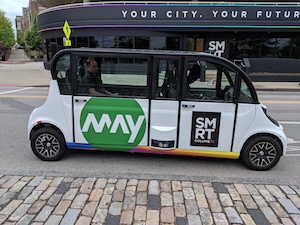This article first appeared in the Traverse City Record-Eagle’s Mobility Forum.
At the dawn of the 1900s, cars were dangerous intruders to cities. In Detroit alone, they caused 31 deaths in one summer. They were unsafe, interfered with streetcars, threatened cyclists and walkers — and cities struggled to keep them controlled.
Headlines read “Council considers city-wide ban on autos,” “City sets 20 mph limit on cars,” and “City removes motorcars blocking sidewalks.”
Yet, over the next 100 years, we would design — and redesign — entire cities around cars.
And today it’s e-scooters that generate the kinds of headlines that once applied to cars.
As director of the T.C. Mobility Lab, I’m excited that Traverse City is creating guidelines for new mobility tools like shared bikes and e-scooters, so we can avoid those headlines here.
These new devices can be valuable assets for reducing car traffic. They provide an effective way for people to get around town without jumping into a car for every trip, and they help bus riders get to bus stops or travel the “last mile” from the bus to their destination.
Like the early cars, they could also be a liability — clogging walkways, blocking paths and littering public places.
To be successful in Traverse City, shared bikes and e-scooters must be deployed alongside community-led guidelines that keep people safe on streets and sidewalks and keep the town decluttered. They must also fit into a larger transportation strategy that includes commuter incentives, smart mobility tools (e.g., phone apps that let commuters track buses or make carpooling easy), and continued investment in buses, shuttles, trails, bike lanes and sidewalks.
As the city explores the best guidelines for these new tools, here are several things to consider:
Permitting: Should the city manage how many devices operate in public and better enforce rules through a permit or license system? Some cities allow devices without permits, others require a lengthy application process.
Operating Zones: Should there be areas where shared bikes and e-scooters can and cannot operate? For example, the city could prohibit e-scooters and bikes from sidewalks in the core downtown and in some neighborhoods.
Parking: Should the city designate specific parking areas for shared e-scooters and bikes? If there’s available parking, riders may be less likely to park them illegally.
Fees: Should the city charge fees for mobility providers and use the revenue for street improvements?
Data: Should city staff require vendors to provide data (such as trip location, complaints, crashes, damages) so city staff can plan effectively?
Safety: Should the city require that devices meet local safety codes?
Equity: Could the city ensure that any new service helps address needs of underserved residents? Portland requires that 20 percent of mobility devices must be located in low-income neighborhoods.
The T.C. Mobility Lab, an initiative that explores ways to improve the local transportation system, looks forward to working with the city and other partners to develop reasonable guidelines for shared bikes and e-scooters. This spring we will host a public forum that explores new mobility options. Stay tuned for a date!
About the author: Jim Bruckbauer is the director of T.C. Mobility Lab, a project of the Groundwork Center for Resilient Communities, where he also serves as deputy director. james@groundworkcenter.org




